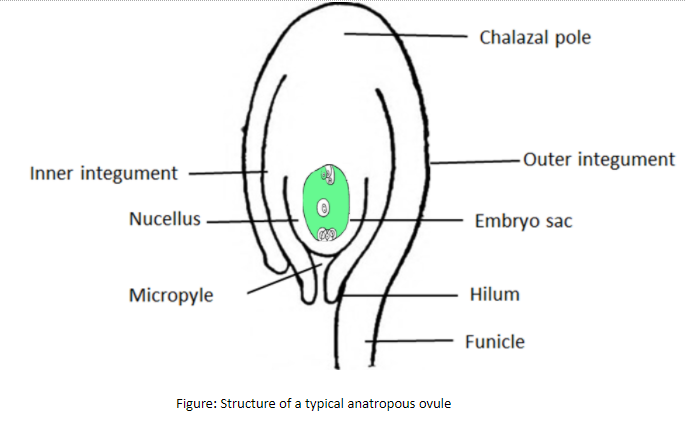
Draw a labeled diagram of an anatropous ovule and label six parts other than the gametophyte.
Answer
517.1k+ views
Hint: In this condition, micropyle is close to the funicular attachment. This is the stage of development where the egg is ready for fertilization by the sperm from a pollen grain.
Complete answer:

In anatropous ovule, the plant ovule is oriented in an inverted condition so that the micropyle is bent down to the funiculus to which the ovule is attached. The chalazal end is located towards the top position. The ovule is a female reproductive part of the plant that eventually develops into the seed after fertilization.
Structure of ovule:
Funicle: It is a small structure that connects the ovule to the placenta.
Hilum: It is the point of attachment where the body of the ovule fuses with the funicle.
Nucellus: This is the body of the ovule that consists of a mass of parenchymatous cells known as nucellus. The nucellus can be massive or thin. The cells of nucellus have abundant food material.
Integuments: Nucellus is enclosed by the one or two or multicellular protective envelopes called integuments. In higher dicots, there is only one integument in the ovule while in monocots or primitive dicots, two integuments are found in the ovule.
Chalaza: It is the place of the origin of integuments that typically lies at the opposite end of the micropyle. It represents the basal part of the ovule.
Micropyle: Micropyle is a pore that presents in the integuments at the end. It is located opposite to the chalazal end.
Note: -In amphitropous condition, the anatropous arrangement of the ovule is tilted 90 degrees.
-In ovule, the megaspores persist inside the ovule and are divided by mitosis to produce the haploid female gametophyte.
-The nucellus is structurally and functionally equivalent to the megasporangium.
Complete answer:

In anatropous ovule, the plant ovule is oriented in an inverted condition so that the micropyle is bent down to the funiculus to which the ovule is attached. The chalazal end is located towards the top position. The ovule is a female reproductive part of the plant that eventually develops into the seed after fertilization.
Structure of ovule:
Funicle: It is a small structure that connects the ovule to the placenta.
Hilum: It is the point of attachment where the body of the ovule fuses with the funicle.
Nucellus: This is the body of the ovule that consists of a mass of parenchymatous cells known as nucellus. The nucellus can be massive or thin. The cells of nucellus have abundant food material.
Integuments: Nucellus is enclosed by the one or two or multicellular protective envelopes called integuments. In higher dicots, there is only one integument in the ovule while in monocots or primitive dicots, two integuments are found in the ovule.
Chalaza: It is the place of the origin of integuments that typically lies at the opposite end of the micropyle. It represents the basal part of the ovule.
Micropyle: Micropyle is a pore that presents in the integuments at the end. It is located opposite to the chalazal end.
Note: -In amphitropous condition, the anatropous arrangement of the ovule is tilted 90 degrees.
-In ovule, the megaspores persist inside the ovule and are divided by mitosis to produce the haploid female gametophyte.
-The nucellus is structurally and functionally equivalent to the megasporangium.
Recently Updated Pages
A man running at a speed 5 ms is viewed in the side class 12 physics CBSE

State and explain Hardy Weinbergs Principle class 12 biology CBSE

Which of the following statements is wrong a Amnion class 12 biology CBSE

Two Planoconcave lenses 1 and 2 of glass of refractive class 12 physics CBSE

The compound 2 methyl 2 butene on reaction with NaIO4 class 12 chemistry CBSE

Bacterial cell wall is made up of A Cellulose B Hemicellulose class 12 biology CBSE

Trending doubts
What are the major means of transport Explain each class 12 social science CBSE

Which are the Top 10 Largest Countries of the World?

Draw a labelled sketch of the human eye class 12 physics CBSE

Explain sex determination in humans with line diag class 12 biology CBSE

Give 10 examples of unisexual and bisexual flowers

State the principle of an ac generator and explain class 12 physics CBSE




